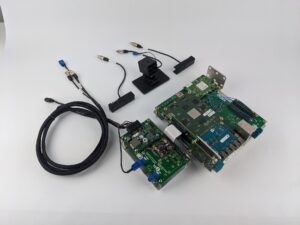OEMs and their Tier suppliers supplying vehicles into the European Union have to embed camera-based driver monitoring systems if they want to keep selling vehicles in the market.
Estimates put the global demand of driver monitoring system (DMS) units at 19 million a year from 2022. The demand is being driven by the Euro NCAP standards and a European Commission (EC) regulation that requires the technology to be fitted to all new four-wheel vehicles from 2022, as well as a U.S. National Transportation Safety Board (NTSB) notice recommending the use of DMS in semi-autonomous cars. Legislation mandating the fitment of DMS is also in the pipeline in other major markets, such as China, India and Japan.

One of the companies which has been gearing up to meet the demand is Seeing Machines. Automotive Industries (AI) spoke to Paul McGlone, CEO Seeing Machines.
AI: You say in your annual results for 2020 presentation that Seeing Machines has reached an “inflection point”. What technology has taken you to that point.
McGlone: Driver monitoring system (DMS) technology has been in play for many years across a range of transport sectors. However, recently, there has been a range of key factors that have influenced the seemingly sudden attention to DMS tech, and this has created what we call an inflection point for the company.
Global regulators and governments continue to strive to improve safety on roads, maintain it across the airways and promote the risks associated with distracted and drowsy driving habits. Europe has been the first to make a serious move. They mean business. The European Parliament has passed a law that camera-based DMS, among a range of other safety technologies, must be fitted in all new cars, vans, trucks and buses from 2024. Euro NCAP (New Car Assessment Program) is also developing protocols for the technology in cars that will achieve five-star safety ratings from 2025. Across the pond, the rise of semi-automated vehicle technology has been the impetus for increased interest in a range of safety technologies, including camera-based DMS. Ensuring that a driver is able to be re-engaged in the task of driving, amidst a range of semi-automated features, is becoming paramount to regulators and safety bodies in North America. Automated vehicle technology is essentially in testing mode, and crashes associated with fully autonomous driving, as well as many involving semi-automated functionality, has inspired organizations like the National Transport Safety Board and National Highway Traffic Safety Administration to pay attention and think about how additional technology can ensure safe adoption of the swathe of new features becoming available in cars, potentially jeopardizing the safety of many people, including pedestrians.
| 68 TO READ THE FULL VERSION OF STORIES GO TO w w w. a i – o n l i n e . c o m |
In summary, the fitment rate for camera-based DMS is set to accelerate quickly. The activity across the automotive sector, in terms of RFQs (request for quotes) has increased substantially. Right now, the early adopters of DMS technology are really the high-end, high-featured vehicles. There’s a total global fitment rate of less than 5%, but by 2026, we expect more than 50% of cars to be rolling off the global production line with DMS incorporated.
AI: Has this influenced your decision to join forces with Qualcomm?
McGlone: OEMs today are faced with a maze of electronics, software and sensor integration options for interior monitoring systems. Coupled with the market dynamics such as regulation and Euro NCAP requirements for safety, we recognize that they need to be supported with a wide range of common integration, cost and safety performance challenges. Seeing Machines launched its three-pillar technology strategy in late 2020 and this enables us to offer options to our OEM customers. Partnering with Qualcomm, industry leader in automotive cockpit solutions, is an example of this strategy coming to life. We work with the right partners to help our customers achieve their goals, safety or convenience focused, and this partnership is focused on helping OEMs integrate smart, safe cockpit solutions across their vehicle platforms.
AI: What does the agreement entail?
McGlone: Seeing Machines and Qualcomm are working together to design an integrated, leading driver monitoring system solution using our driver and full cabin
monitoring technologies for Qualcomm Snapdragon Automotive Cockpit Platforms and for the Qualcomm Snapdragon Ride Platform. As a part of the relationship, Seeing Machines is working with Qualcomm Technologies to further optimize its technology stack for the Snapdragon Automotive Cockpit Platform architecture and its acceleration hardware for automakers and Tier-1 suppliers. In addition, Seeing Machines’ previously announced Embedded Development Kit (EDK) for the Snapdragon Automotive Cockpit Development is now available to select Tier 1 and OEM customers.We will jointly market the solution and expect to leverage Qualcomm’s position across the automotive industry, meaning we do expect this engagement to deliver significant incremental volume on top of our existing business plan.
AI: What will be the benefits to OEMs and Tier 1s?
McGlone: Our path to integration with Qualcomm Technologies’ Snapdragon Automotive Platforms has been designed to leverage our unique systems knowledge and safety focus in a way that supports complete flexibility for Tier-1s and OEM customers as safety and convenience features become more expansive and complex across high volume and diverse vehicle platforms.
AI: What is the importance to OEMs of the investment you have attracted from US institutions?
McGlone: Interest from US investors has never been so great. This not only validates the technology for the long-term and reinforces what we have known for a long time, DMS is a technology that is central to the automotive industry now, and investors are recognizing the importance of that and demonstrating that with their investments. Further, the additional interest and investment has shored up our balance sheet to deliver not just programs we have won, but those we are now pitching to win. We are here for the long term and fully funded to meet the accelerating demand for our industry leading tech.
AI: In your presentation you spoke about income from automotive licensing agreements. How is this structured?
Our Automotive licensing agreements are negotiated on an individual basis, depending on our customer’s needs.
AI: Where to now technologically for Seeing Machines?
McGlone: DMS is at the early stage of take up, with a strong growth path ahead. We continue to develop our technology, working with our customers and partners to help them achieve the safety and convenience outcomes they desire for their vehicle platforms. We recently launched Occupant Monitoring System (OMS) technology, which utilizes a wide field of view camera that can now monitor the driver and passenger(s) for a range of safety and convenience features, and we have recently announced our first award with a US OEM to deliver DMS/OMS as a combined solution.

Our technology is leading edge. Our Occula™ Neural Processing Unit is application specific and may be licensed. It is highly optimized to accelerate algorithm architectures that we have found to be most effective for detecting and tracking humans. We have implemented this across our FOVIO Chip family of products which enables best-in-class driver monitoring algorithms to run with industry leading performance characteristics. Further, we continue to partner with our Tier 1 customers and semi-conductor companies to provide a range of options for our customers in terms of low-friction integration pathways into any vehicle integration point, including smart mirrors, instrument clusters, infotainment ECUs or centralized ADAS processing systems.












More Stories
DuPont materials science advances next generation of EV batteries at The Battery Show
How a Truck Driver Can Avoid Mistakes That Lead to Truck Accidents
Car Crash Types Explained: From Rear-End to Head-On Collisions